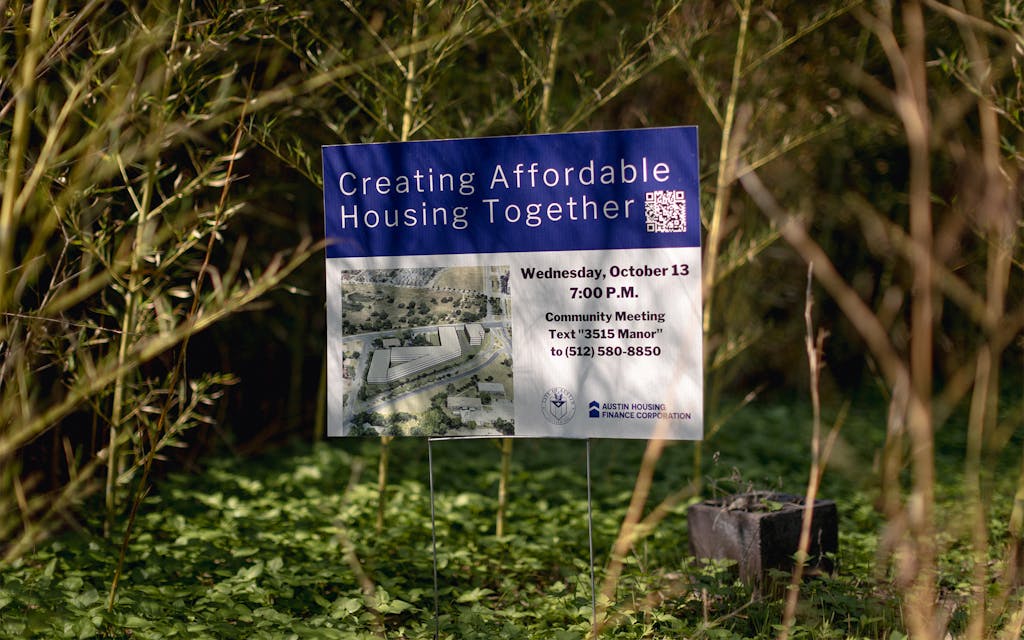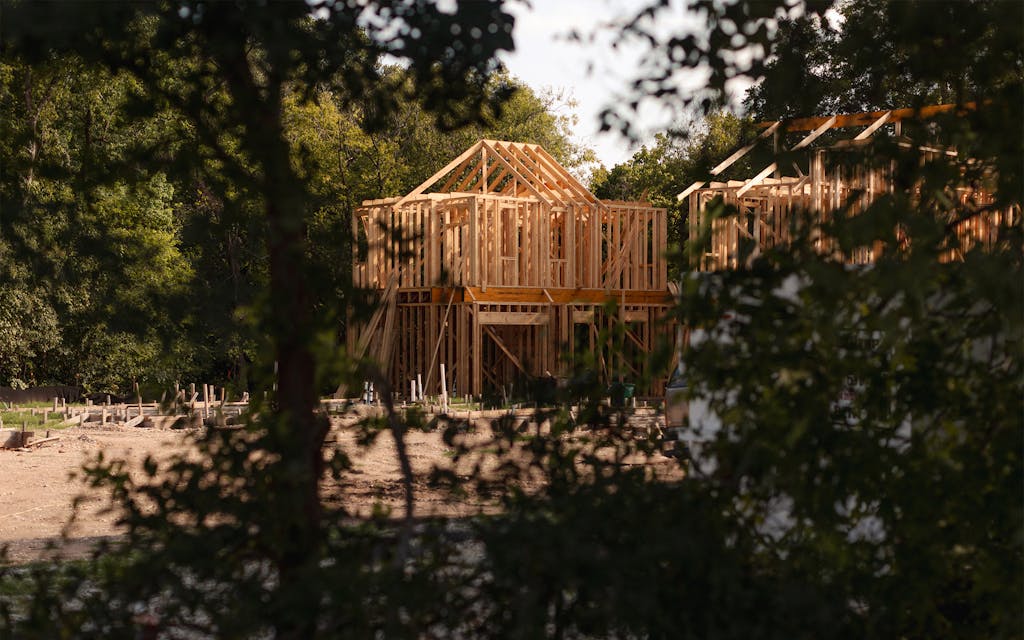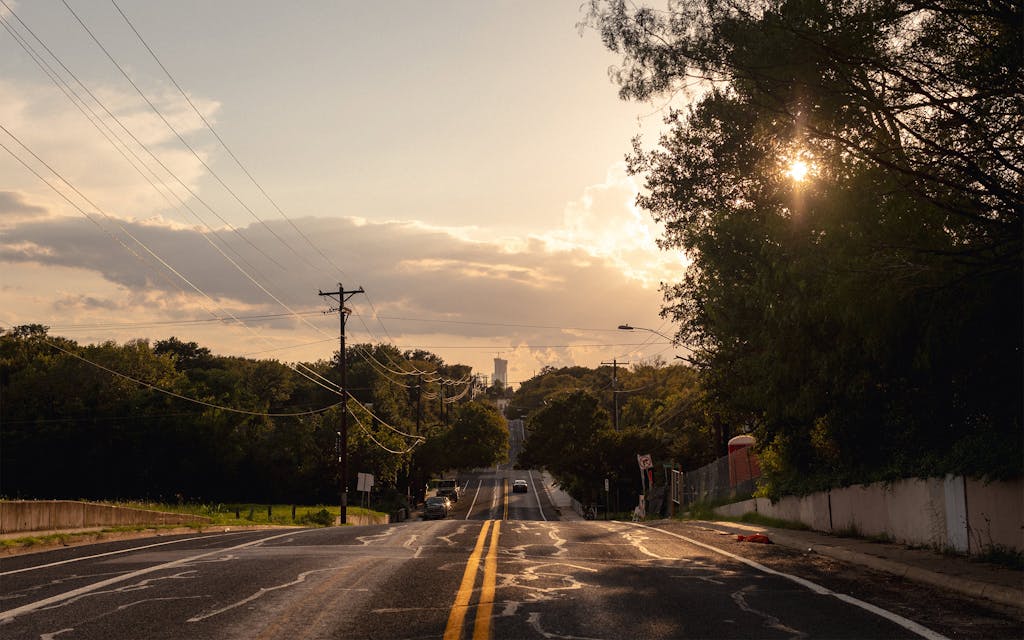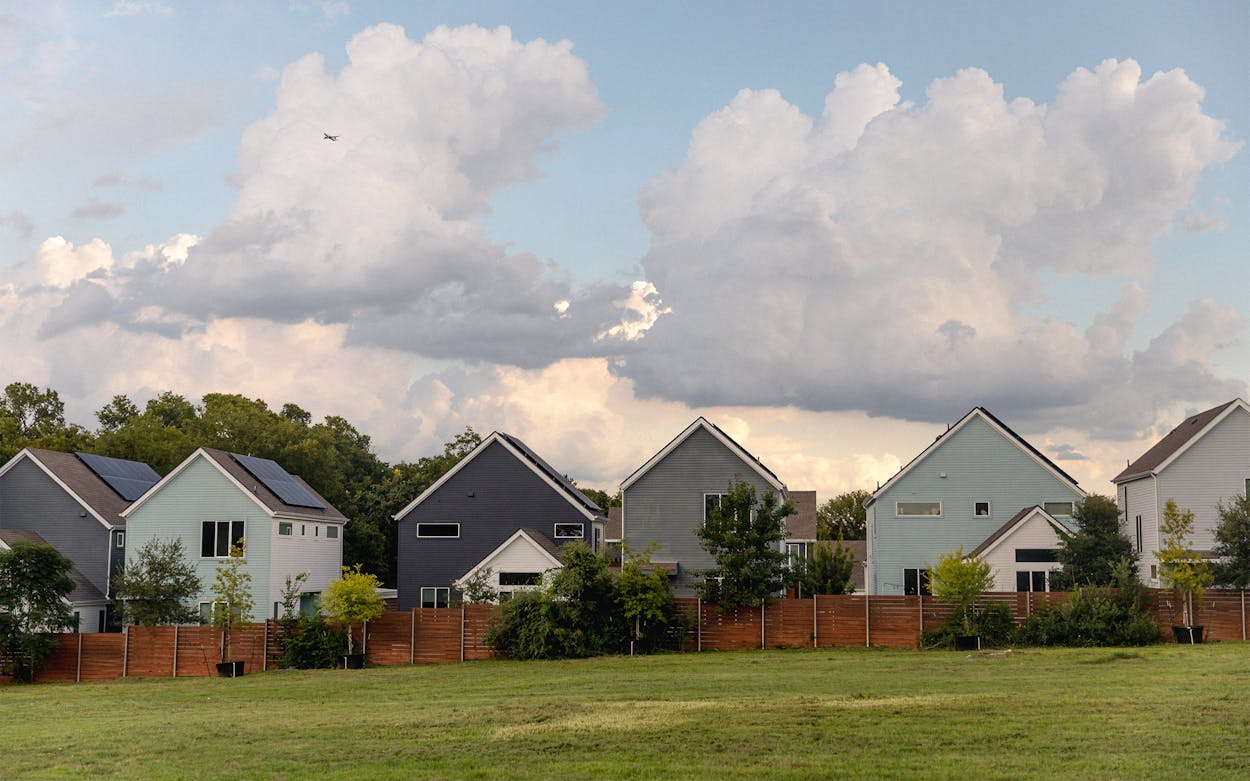After Chris Gannon and Leyla Shams bought a house on E.M. Franklin Avenue, they sometimes walked just up the street to a densely forested three-acre lot of sprawling trees and lanky bamboo next to a small, spring-fed creek. The land was owned by Lee Daniel, the cinematographer best known for his work on the iconic Austin films Slacker and Dazed and Confused. Daniel had moved an old house from New Orleans onto the property and invited artists to camp there and show their art. “You’d go there and really you couldn’t tell what art was what they were showing, and what was a collection of pans that they had,” Gannon said.
The couple, both architects, soon started a family and began renovating the 1939 home they bought in 2015, but their lush, quiet corner of East Austin began to change. Neighbors and friends were priced out. Older bungalows were torn down and replaced by towering, multimillion-dollar houses. Daniel sold his lot in 2018, and a real-estate investor clear-cut it, bulldozing the heritage oaks.
Then, in the summer of 2020, a developer named Anmol Mehra showed up to a neighborhood association meeting and explained that he was thinking about buying the clear-cut land, as well as the lot next door, to build a mixed-income, multifamily development on the four-acre parcel. He wanted to know what the neighborhood thought. That simple question would spark a two-year conflict. “It caused such havoc,” Gannon said.


A University of Texas at Austin graduate, Mehra had spent most of his career in finance, working for Fidelity Investments in Boston. But he returned to Austin often, splitting time between the two cities. His parents had come to the United States from India, eventually landing in Houston. “As a child of immigrants, I’ve always wanted a place to be as inclusive and welcoming as possible,” he said. It bothered him that Austin was becoming increasingly unaffordable. He didn’t want to see a city with proximity to considerable centers of power—such as UT and the Capitol—open only to the wealthiest.
Mehra started small, buying investment properties and renting them out to artists and others who might not otherwise be able to afford living in Austin. “My juices started flowing, thinking about ways to marry social good and financial benefit,” he said. Soon he became interested in development. He’d often heard residents oppose new housing because it would disrupt a neighborhood’s character. “To me that’s almost code for ‘we don’t want you here,’ which is really upsetting. I think we should be welcoming to more density and all types of people,” he said.
Under the E.M. Franklin property’s existing zoning, Mehra could subdivide the lot and build 22 single-family homes, which would likely sell for upwards of $1.5 million each. That didn’t appeal to him. The proposal he eventually presented to the neighborhood association included 143 units of housing—a mix of townhomes and condominiums—roughly 30 percent of which he said would be sold to families earning on average about 80 percent of Austin’s median annual income, $88,000 for a family of four. But to do that, he would need to ask the city to rezone the property.
Mehra’s plan proved divisive. Lauren Stanley and her husband, Lars—also both architects—lived, with their two teenage sons, across the street from Gannon and Shams. Stanley believed Mehra’s proposal would add far too much new housing in the middle of a block of mostly single-family homes. She said the street couldn’t handle the additional traffic and argued that the project would pave over the natural filtration system that protected the adjacent creek. “They need to find another property to do their wonderful, beautiful project on,” she told me. “There’s something called site appropriateness. We all believe density should happen in the city, but it’s not a matter of more is more. Sometimes more is less.”

There are not enough homes in Texas for everyone who needs one. As a result, prices have skyrocketed, climbing more than 45 percent statewide since the start of 2020, according to Zillow. That year, Freddie Mac estimated that the state needed half a million new homes to meet rising demand, including from the thousands of newcomers arriving in the state each week. This shortage affects homeowners and renters alike: in 2021, a Zillow report found that Dallas had the highest shortfall of single-family home permits issued compared with population growth; Houston and Austin weren’t far behind. And Texas is among the worst states in the country for low-income renters, according to the National Low Income Housing Coalition, with a shortage of more than 600,000 rental units.
These shortages have been felt most acutely in Austin. Since the pandemic began, home prices have increased faster in the capital than almost anywhere else in the country. In June, the median home price was $615,000, a 48 percent jump since March 2020. Median rents have increased by 40 percent during the same period, according to Redfin data.
Despite nearly everyone agreeing that Austin needs much more housing, no one can agree on where it should be built. That question should, in theory, be answered by a comprehensive land development code, which would dictate through zoning categories what can be built and where it can go. Austin last updated its code in 1984, when the city was home to fewer than half as many residents. The city has attempted to rewrite those regulations, but that effort failed earlier this year, after homeowners responded with fierce resistance and eventually a lawsuit.
That leaves neighborhood fights such as the one that played out on E.M. Franklin to determine Austin’s future—namely, whether it will provide enough housing for a growing, diverse population—as homeowners negotiate with developers over what they will permit in their backyards.


The term “NIMBY”—an acronym that stands for “not in my backyard”—was initially used to refer to environmental advocates fighting to keep hazardous waste facilities away from residential neighborhoods. For much of the twentieth century, top-down urban planning bulldozed communities of color in order to build projects ostensibly defined as progress—a highway, a fairground, a landfill. “So there was a reaction to that, saying communities, particularly low-income and nonwhite communities, should have more of a say,” said Jenny Schuetz, a senior fellow at the Brookings Institute, in a recent interview. But over the past several decades, that reasonable idea has been “weaponized by wealthy, white communities,” she said, to oppose any new development, including apartments and affordable housing.
The mechanism for that opposition is zoning. Most residential land in Austin—as in cities across the country—is set aside for single-family homes. A developer who wants to build multiple housing units on a single-family property has to request approval to do so from both the planning commission and city council. Across the state, property owners have fought zoning that would bring more homes to their neighborhoods. In August, officials in Boerne, outside of San Antonio, killed a 223-unit multifamily project after residents protested. In Arlington, homeowners have fought a zoning change that would allow more “missing middle” housing—anything between an apartment and a single-family home—to be built throughout the Tarrant County city.
Single-family homes exert more influence in Austin than in any other Texas city. In June, city staff looked at compatibility standards, which limit what can be built next to what, and found that Austin has some of the most restrictive rules in the country. To build a five-story apartment building, for example, a developer must locate it at least three hundred feet from any single-family home. In Dallas and San Antonio, that distance is fifty feet. In zoning-free Houston, it’s zero. The difference represents thousands of potential units of housing.

In Texas, if enough nearby property owners oppose a rezoning request, they can submit a petition that requires it to garner the support of three quarters of the city council. Mehra faced such opposition a few years ago, when he bought a duplex in the Blackland neighborhood of East Austin and proposed replacing it with five townhomes, one of which would be sold to a lower-income family at a below-market price. Neighbors opposed the project. After a long, contentious fight, the rezoning was narrowly approved by the council. Mehra wanted to avoid that same sort of costly delay on E.M. Franklin, so shortly after he bought the land, he and a colleague spent two days knocking on every door in the surrounding neighborhood, called J.J. Seabrook in honor of a prominent Black pastor and former president of Huston-Tillotson University.
Tucked just south of what was once Robert Mueller Municipal Airport, for most of its history J.J. Seabrook was home mostly to Black families, along with some warehouses and green space. Dianna Dean, who is Black, grew up in East Austin when the city was still effectively segregated by Interstate 35, and earned a nursing degree from Austin Community College. In 1995, she brought her mother and grandmother with her to look at a house that she was thinking about buying on E.M. Franklin. Together they walked around its half-acre lot and through the gable-roofed home, built in 1944. Her mother turned to her and said, “This is your house,” Dean recalls. “I said, ‘Mom, I really didn’t want this old house,’ and she said, ‘Don’t worry about the house, it’s the land.’”
Dean moved in and got used to diving out of her bed onto the floor whenever a plane passed overhead, shaking her entire home. The street led to one of the airport’s main entrances, so during busy travel periods Dean charged for parking on her expansive front yard. But in 1999 the airport moved south of the city, and Dean could enjoy her newly quiet neighborhood, which thrummed with wildlife—foxes and birds and butterflies. “It was heaven,” she said.
When Mehra knocked on her door, she told him she worried he was going to destroy her beloved creek. She liked him, but she couldn’t support his project. “That’s a natural system back there. Once we tear it up or change it, we can’t get it back.”


In 2013, Liz Johnson moved with her husband and four kids to Austin from New York City, which they loved but could no longer afford. They bought a house on E.M. Franklin, three doors down from Dean. When the longtime president of the J.J. Seabrook Neighborhood Association stepped down in early 2021, Johnson agreed to lead the group. She had lost her job at St. Edward’s University during the first year of the COVID-19 pandemic and had time on her hands.
The neighborhood association had been talking with Mehra about the project for nearly a year, but Johnson felt the developer wasn’t taking its concerns seriously. “He made a lot of presentations and not a lot of changes,” she said. So Johnson sent out an anonymous questionnaire asking neighborhood residents to indicate their support or opposition to the proposed rezoning. Among the nearly eighty responses, opinion was split: 47 percent supported the rezoning, while 53 percent opposed it. Opponents of the project insisted it was too big for the location. It would “open the floodgates for a wholesale leveling and multifamily redevelopment of the neighborhood,” one resident wrote. Another insisted: “Great project, wrong location.”
From their backyard, which overlooked Mehra’s vacant lot, Matthew and Sarah Welch saw things differently. Matthew had grown up in Austin, splitting time between his mother’s house in the city and his father’s in the rolling countryside to the west, where over the years he watched trees felled and earth covered in concrete for upscale housing developments. “So when Anmol came along and said, actually, I want to do more density, I want to make it walkable, I want to make it accessible to a range of incomes, it was just music to my ears,” he said.
The Welches live in a five-acre community called Franklin Grove, just to the south of Mehra’s property. Its builder originally sought, a decade ago, to erect a denser development of smaller single-family homes. The company met with the neighborhood association, just as Mehra did, but abandoned its plans after nearby homeowners said they would fight the necessary zoning change. Instead, the company built 28 single-family homes—25 percent fewer than it initially planned. (Matthew works for Franklin Grove’s builder, as its general counsel.) When Matthew and Sarah helped conduct a survey of Franklin Grove homeowners, they say, support for Mehra’s proposal was nearly unanimous.
As the months wore on, the divide among neighbors grew tense. Folks who used to routinely say hello wouldn’t make eye contact when they passed each other on the street, Gannon said. Confusing to Gannon and Shams was that the neighborhood association seemed unified in its commitment to affordability, diversity, and the environment—having sent a letter to Mehra stressing as much—but residents had radically different ideas about how to ensure those values. “To us, it’s like, the only way to achieve that is with density,” Shams said. Many neighbors wanted Mehra to build fewer units on the land, preserving some of its wild character, but still wanted those units to be sold at lower prices. “The things that they were proposing were magical thinking.”
Across the street, Stanley believed her neighbors were dismissive of her concerns. She doesn’t see herself as a NIMBY, but she was protective of what the neighborhood had already lost. “I feel like there’s a little bit of respect that’s not there for people who have been there longer,” she said. “You’re pretty much scrubbing the history of Austin and Austin residents if you just let this train just full-steam ahead.”

In February, thirteen homeowners on E.M. Franklin—including Johnson—submitted a petition to the city opposing Mehra’s zoning change. “In a time when we face grid deficiencies, a taxed city infrastructure, and climate change, we should be taking the need for community resilience extremely seriously,” they wrote. They would support a “moderate upzoning” that “provides housing that complements the existing neighborhood fabric.”
Homeowners turned out en masse when the case was heard before the planning commission in April. Many insisted that the neighborhood was already doing its part to provide affordable housing, citing the more than one thousand units already in the works along Manor Road, on the northern edge of J.J. Seabrook. Indeed, East Austin has seen the lion’s share of new housing projects in the city. In part, this is because homeowners in West and Central Austin have so effectively resisted anything but single-family housing that many developers don’t even try to build in those areas anymore. And even today, land remains cheaper in East Austin after decades of segregation and racist public policy that depressed property values.
“The zoning system is rigged,” said Leah Bojo, the director of land use and entitlements at the Drenner Group, an Austin law firm that represented Mehra’s rezoning request. “People think it’s rigged toward developers, but I actually think it’s rigged toward whoever lives really close to the site that’s being rezoned or redeveloped, which is often single-family homeowners . . . Those folks have more rights, both politically and legally, to stop or change the request.”
Yet in July, the Austin City Council approved the rezoning in a 10–0 vote. Even though Mehra’s rezoning was approved, the paradigm remains unchanged: his request likely succeeded only because he had the support of the Franklin Grove homeowners, Bojo said.
Without comprehensive land use reform, “every zoning case is now a fight. Every development is a fight,” said Greg Anderson, the director of community affairs for Austin Habitat for Humanity and a member of the city’s planning commission. Rather than asking the city council to spend hours weighing in on every rezoning case—Mehra’s project will provide only 143 units of housing in a city that needs more than 135,000 new homes—the process should be handled by city staff, Anderson said, who can accelerate projects that meet the city’s larger priorities and goals.
A new land-development code would address other issues as well. Austin’s permitting process is notoriously slow, which both drives up the cost of development and throttles the housing supply. Austin’s complicated land development code is also often contradictory, said a land development consultant who didn’t want to be named because of his relationships with city staff. “You just can’t pull up a zoning map and know exactly what you’re allowed to do on the site,” he said. “Most cities are easier to develop in because their code is simpler.” In Austin, it can take upwards of a year to get a site plan approved for a multifamily development, while other Texas cities manage the same task in three to four months, he said.
It also costs more to build housing in Austin than in any other Texas city. In July, a report from the Home Builders Association of Greater Austin and the Austin Board of Realtors found that fees for multifamily residential development are significantly higher in Austin than any other city in Texas. Those fees are passed along to homebuyers, comprising as much as 20 percent of a mortgage for a family earning the city’s median income, the report found.
The day after the rezoning passed, Mehra was already sizing up his next hurdles: getting a site plan approved and then securing construction permits, which could require another two years. In the best-case scenario, he said, residents will move into the new housing in early 2025.
As for life back on E.M. Franklin, Gannon and Shams are hopeful that the conflict will blow over. “As soon as it’s built and people are there, they become our new neighbors,” Gannon said. “We meet them, we like them, we don’t like them, whatever. It’s not about the project anymore. It’s about the community.”
Despite her opposition to the project, Dean feels the same way. “I like to see the babies walking up and down the street, people walking their dogs,” she said. She misses her trees and foxes, but this new vitality energizes her. She’s made friends with some of the people who bought homes in Franklin Grove. “People still need somewhere to live. We have to grow, and we have to be resilient. Let’s go ahead and build out, and get it done, and get to living.”
- More About:
- Politics & Policy
- Austin






